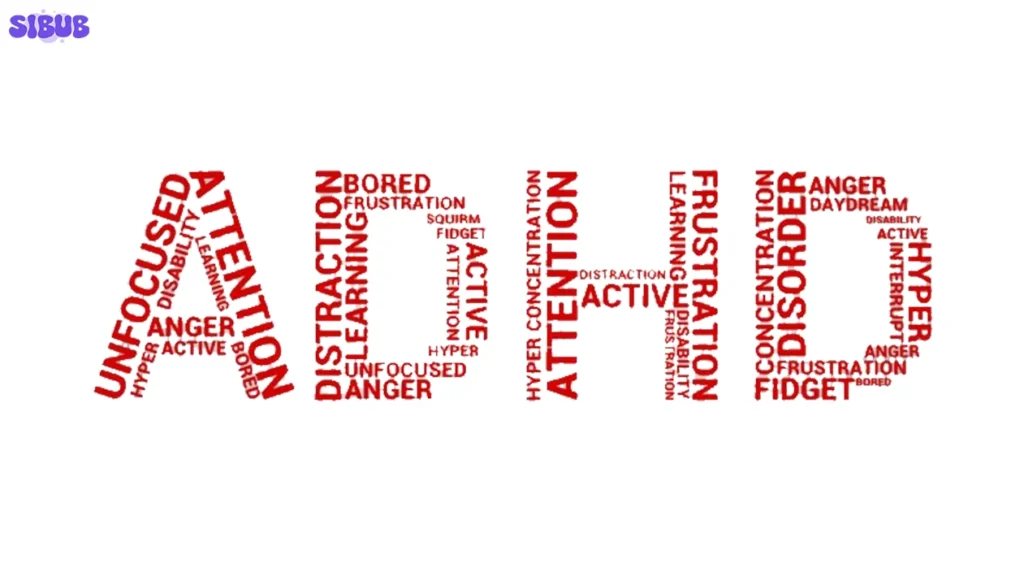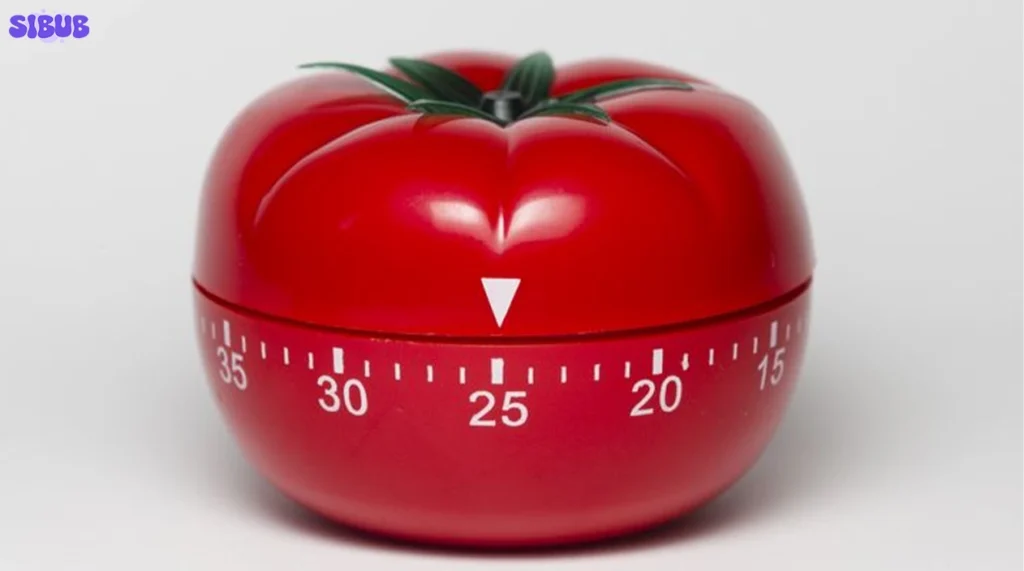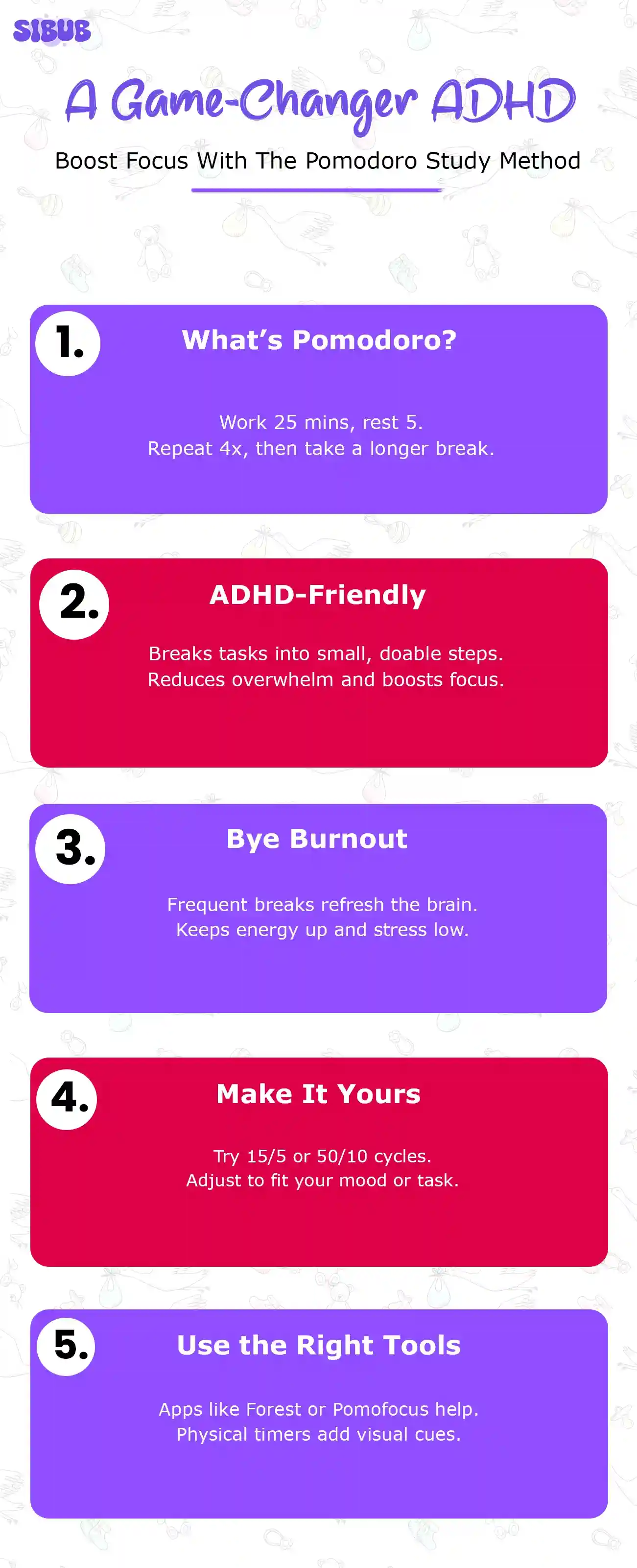Consider attempting to read a single page while simultaneously your mind races with ten different irrelevant thoughts. That is how life feels for an ADHD patient. But what if there was a simple fix that relied on timers that could trick your mind into concentrating? Enter the Pomodoro Study Method – a productivity technique that turns time into your ally.
“You don’t need more time; you just need to use it better.” – Francesco Cirillo, creator of the Pomodoro Technique
In this article, we will look at how the Pomodoro method is tailored for ADHD, how to adjust it, and what tools suit it best.
What is the Pomodoro Technique?
Before explaining its advantages for ADHD, let’s get the basics out of the way
Established in the 1980s by Francesco Cirillo, the Pomodoro Technique is a time management strategy, named after the tomato-shaped kitchen timer he uses. The technique is deceptively simple:
- Try to work for 25 minutes (1 Pomodoro)
- Then, take a 5-minute break
- After 4 Pomodoros, take a longer break of 15, 20, or 30 minutes

Visit: 9 Printable Feelings Chart for Kids To Support Emotional Growth
The Pomodoro Technique assists in breaking down overwhelming tasks, improving productivity while also decreasing burnout and procrastination. It’s incredibly effective for those with attention deficits.
The structure of this Pomodoro study method helps provide a tangible outlook for time, which individuals diagnosed with ADHD tend to struggle with greatly.
Reasons for the Effectiveness of the Pomodoro Study Method For ADHD
More than just boosting productivity, the Pomodoro study method prevents distractions, builds structure, improves emotional control, and much more—everything an ADHD brain needs.
ADHD and the Problem of Perceiving Time
People who have ADHD experience time blindness, an inability to accurately estimate deadlines and the time it takes to complete tasks. With the aid of a visual and tactile instrument like a timer, the Pomodoro technique places time in clear view.
For ADHD users, a Pomodoro timer app facilitates time externally, making it easier to perceive and conceptualize.
Less Overwhelm Leads To More Momentum
Splitting work into 25-minute intervals reduces the stress associated with long-term tasks. Looking at a two-hour homework block becomes “one Pomodoro”.
This method enhances task initiation, a complex executive function that ADHD individuals find especially challenging.
According to ADDitude Magazine, ADHD patients have improved follow-through by more than 40% as a result of chunked tasks.
Discover: ADHD Treatment For Kids: Finding The Right Medication
Burnout is Less Likely With Built-In Breaks
Short pre-planned breaks reset attention, diminishing the chance of burnout. The ADHD brain craves novelty, and the 5-minute breaks provided in this method help by offering time to refresh, stretch, and move, without losing focus.
As per the study in Psychiatry Research, people with ADHD improve from task-switching patterns, which lessen mental exhaustion. That is precisely what the Pomodoro technique provides.

How to Adapt the Pomodoro Method for ADHD
The method works well, but some adjustments that make it more ADHD-friendly.
Try the 50/10 Method
People with ADHD sometimes find that entering “flow” is harder to do in the given 25 minutes. If that’s you, try the 50/10 method: working for 50 minutes, then taking a 10-minute break.
Some folks work better with 15/5 cycles to keep things fast-paced.
The key is testing, adjusting, and having flexibility. That flexibility is important when adapting the Pomodoro study method to ADHD.
Use a Dedicated Pomodoro Timer
Dedicated timers like the Time Timer or Focus Keeper app serve as external time markers, reinforcing concepts visually.
Recommended tools:
- Focus To-Do combines task lists with Pomodoro timers.
- Pomofocus.io is a simple online Pomodoro timer app.
- Forest App gamifies focus by letting users grow virtual trees.
These tools outline steps to be taken and help maintain accountability and rhythm.
Explore: When Does an Infant Get Teeth? 7 Things Parents Should Know
Change According to Mood/Task Nature
Every task does not needs an equal share of time. Reading might need 15-minute sprints, but writing may require 50. Give yourself room to flex if your energy is low in order to avoid frustration. People with ADHD tend to resist tasks. The method makes them more approachable by low-pressure entry points where the burden of demand is minimal.
Missteps and How to Sidestep Them
Rest assured, even the finest techniques fail when mishandled. Let’s see how we can resolve the conflicts that accompany the Pomodoro technique for people with ADHD.
Timer Fatigue
Some users have noted that they feel “boxed in” and restricted by the use of the clock. If timers heighten anxiety, regard them in a more simplistic manner and shift to a more abstract visual representation, or just try having periodical music play in the background on a soft start.
ADHD brains tend to enrapture themselves with the idea of a ticking clock, hence relying on a timer being kept out of sight, yet having the sound on will solve problems.
Break Drift
A break that turns into scrolling for an hour on TikTok is no longer to your advantage. Alarms can be created to remind you when to wrap it up. Assist yourself in reducing mental bandwidth with breathing exercises.
A good number of ADHD users are anchored better using a pomodoro clock or tick mark break chimes.
Perfectionism and Over-Planning
Don’t waste primer on your pomodoros, don’t spend 30 minutes mapping things out. Analysis paralysis is often a byproduct of ADHD. The Pomodoro study method remedies this problem by motivating students to take action right away.

How to Use Pomodoro in Your Daily Life
Integrating structure into one’s life is important for a person with ADHD, and routines help simplify things. Here is how you can use the Pomodoro technique within your daily flow.
Start Every Day with a Focus Plan
In your morning ritual, record at most your 3 priorities for that day. Break your goals into manageable pieces. Doubling mental clarity helps with motivation as well. Oftentimes, everyday rituals propel us forward without impediments.
Using Pomodoro Clocks
These are tangible and external cues. Unlike the Ring or Apple watches that many people often rely on, the TickTime and Time Timer MOD are devices that act as constructive reminders for when you are meant to be busy at a task, and hence serve as motivation.
Stacking for Optimal Performance
By virtue of sessioning, you group similar tasks together. For people who are motivated by coffee or teeth brushing, assign those events before starting a session. With the help of these designated Pomodoro sessions, switching focus becomes simpler.
With time, you can connect numerous Pomodoros into a chain, gradually building blocks of deep work, adaptable to your rhythm.
Last Words
The Pomodoro study method is more than just a passing productivity fad. It is a semi-structured tool that is tailored for ADHD. With the right changes, the Pomodoro technique makes timers great tools instead of enemies.
Whether a student, parent, or adult with ADHD, this method helps restore your control of time and the disorder. Each tick of the timer reinforces us away from chaos.
Visit us at Sibub.com to access our newest posts and parenting tools, and ADHD related assists.
